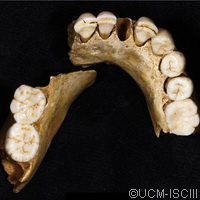New data show Neanderthals died off before modern Man appeared
The extinction of most Neanderthals in Europe occurred some 50 000 years ago, years before the our Homo sapiens ancestors made their presence known on the continent, new international research shows. Presented in the journal Molecular Biology and Evolution, the findings counter what most researchers have long believed: a stable Neanderthal population lived in Europe for hundreds of thousands of years before modern Man arrived. The data show that after most Neanderthals died off, a small group of Neanderthals recolonised central and western Europe. There, they survived for another 10 000 years before our ancestors appeared. Led by researchers from Spain and Sweden, the team used information previously obtained on deoxyribonucleic acid (DNA) from Neanderthal fossils in the northern part of Spain. According to the team, the genetic variation among European Neanderthals was very limited during the last 10 000 years before the Neanderthals disappeared. 'The fact that Neanderthals in Europe were nearly extinct, but then recovered, and that all this took place long before they came into contact with modern humans came as a complete surprise to us,' says Professor Love Dalén from the Swedish Museum of Natural History in Stockholm. 'This indicates that the Neanderthals may have been more sensitive to the dramatic climate changes that took place in the last Ice Age than was previously thought.' The researchers point out how older European Neanderthal fossils and Asia-based fossils had greater genetic variation, on par with the amount of variation that might be expected from a species strongly populating an area for many years. Says Professor Anders Götherström at Sweden's Uppsala University: 'The amount of genetic variation in geologically older Neanderthals as well as in Asian Neanderthals was just as great as in modern humans as a species, whereas the variation among later European Neanderthals was not even as high as that of modern humans in Iceland.' The team says the data are based solely on severely degraded DNA. So both advanced laboratory and computational methods were needed to perform the analyses. Also forming the team were researchers from Denmark and the United States. They said only when they all reviewed the findings could they be sure that the available genetic data actually revealed an important and previously unknown part of Neanderthal history. 'This type of interdisciplinary study is extremely valuable in advancing research about our evolutionary history,' explains Juan Luis Arsuaga, a human palaeontology professor at Universidad Complutense de Madrid in Spain. 'DNA from prehistoric people has led to a number of unexpected findings in recent years, and it will be really exciting to see what further discoveries are made in the coming years.'For more information, please visit: Molecular Biology and Evolution:http://mbe.oxfordjournals.org/Swedish Museum of Natural History:http://www.nrm.se/en/frontpage.16_en.html
Countries
Spain, Sweden



